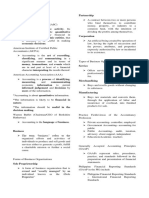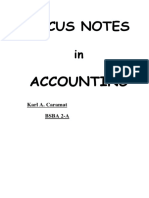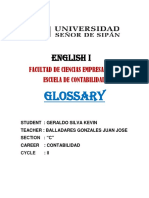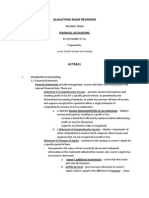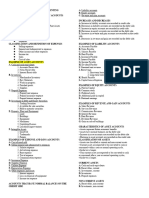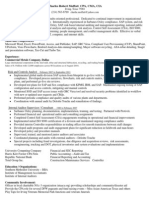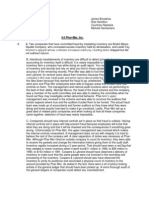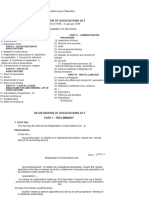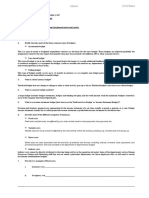ACCOUNTING
It is an art of recording, classifying, summarizing in a significant manner and in terms of money,
transactions, and events which are, in part at least of a financial character, and interpreting the results
thereof.
Recording – is the phase of accounting which involves the routing and mechanical process of writing down
the business transactions and events in the book of accounts in a chronological manner called
“JOURNALIZING”.
Identifying – there should be a basis of determining whether such were business transactions or not. As a
rule, only transactions with financial bearing to the business are recognized.
Classifying – is the phase of accounting which involves sorting or grouping of similar transactions and event
into their kind and classes. It is the process of transferring the entries from the Journal to the
Ledger called “POSTING”.
Summarizing – is the phase of accounting which involves the completion of the financial statements and the
accounting requirements as well.
Interpreting – is the phase of accounting which involves the “analytical and interpretative works”.
BOOKKEEPING
Is the process of recording “systematically” the business transactions in a “chronological manner”.
The records that should be kept by the business for that purpose are called “book of accounts”. What has been
recorded in books of accounts are data that are financial in character which are processed and transformed into a
report form called “financial statements”.
Career Opportunities of an Accountant?
Public Accounting – A public practice were render a services to the public for a fee. It is either, individual
practitioners and join partnership.
Government Accounting – were render services to the government. (DFSEC, BSP, BIR)
Private Accounting – employed in private firms and hold positions as Chief Accountant, Accounting Manager,
Internal Auditor, Finance Manager, and highest Accounting Officer called Comptroller.
Accounting Education – a profession for the sake of love in accounting education.
Specialized by a Professional Accountants:
1. Financial Accounting – concerns primarily in describing the financial resources, obligations and activities of an
economic entity resulting to the preparation of general-purpose financial reports.
2. Auditing- classified into two: Internal and External – the established accounting procedures are being
followed throughout the year.
3. Management Accounting – concerns with the designs, installation and improvements of accounting system
intended specifically to help management in running the business.
4. Tax Accounting – involves the preparation of income tax returns and the determination of correct amount of
taxes due and payable to the government.
5. Financial Management – its primary concerns is to set-up financial planning objectives-including the sources
and application of its resources beneficial to the economic entity.
6. Cost Accounting- concerns primarily on cost collection, allocation and control of producing goods and
services.
7. Government Accounting – deals primarily on the proper custody of public funds in both national and local
government, such as cities, provinces, municipalities and barangays.
Financial Statements – is to provide information about the financial condition and operating results of an enterprise
that is vital in making sound economic decisions. The accountant’s reports to the proprietor which
are considered the “end products”.
�5 Elements of Financial Statement:
1. ASSETS - defined as things of value that are owned and used by the enterprise in its operations.
2. LIABILITIES – defined as financial obligations of the business to its creditors. It represents the claim of the
creditors over the assets of the enterprise.
3. CAPITAL/OWNER’S EQUITY – refers to money or value of property put by the proprietor into the business to
start with.
4. INCOME- refers to the proceeds from services rendered by a servicing firm.
5. EXPENSES – are the gross outflow of economic benefits during the period arising in the course of ordinary
activities of an enterprise.
4 Basic Financial Statements:
1. Balance Sheets or Statement of Financial Position – is a statement which shows the financial condition
of the business as of a given date. (Permanent Accounts)
Basic Equation : Assets = Liabilities + Capital
2. Income Statement – is a statement which shows the “results of operation” of the business for a given
period of time. (Temporary Accounts)
3. Statement of Changes in Owner’s Equity – is a statement that summarizes the changes in equity for a
given period of time.
4. Statement of Cash Flows – it refers to the in and out cash of the activity of the business firm.
(3 kinds of Statement of Cash Flows: Operating Activities; Investing Activities; Financing Activities)
ASSETS
Two classifications:
1. Current Assets – refer to all assets that are expected to be realized, sold or consumed within the
enterprise’s normal operating cycle.
CASH – the account title ro describe money, either in paper or in coins and money substitutes like
check, postal money orders, bank drafts and treasury warrants. (Cash of Hand and Cash in Bank)
PETTY CASH FUND – the account title for money placed and set aside for petty or small expenses.
CASH EQUIVALENTS – as short term, highly liquid instruments that are readily convertible into cash.
NOTE RECEIVABLES – this is a promissory note that is received by the business from the customers
arising from rendering of services, sale of merchandise
ACCOUNTS RECEIVABLE – the account title for the amounts collectible arising from services rendered
to a customer or client on credit or sale of goods to customers on accounts.
ESTIMATED UNCOLLECTIBLE ACCOUNTS – this is an asset offset or a contra-asset account. It provides
for possible losses from uncollected accounts.
ADVANCES TO EMPLOYEES – the account title for amounts collectible from employees for allowing
them to make cash advance which are deductible against their salaries or wages.
INVENTORIES – held for sale in the ordinary course of business.
- In the process of production for such sale
- In the form of materials or supplies to be consumed in the production process or in
the rendering of services.
Inventories Classified as:
Merchandise Inventory, End – this refers to unsold merchandise at the end of the
accounting period as determined by physical counting or inventory taking.
Supplies Inventory or Unused Supplies – an account title for cost of stationery and
other supplies purchased for use but are left on hand and still unused.
PREPAID EXPENSES – account title for expenses that are paid in advance but are not yet incurred or
have not yet expired.
2. Non-Current Assets – (ready conversion to cash) defines property and equipment as “ tangible assets
which are held by an enterprise for use in production or supply fo goods and
services, for rental to others, or for administrative purposes, and which are expected
� to be used during more than one period, such as:
BUILDING – account title for a finished construction owned by the business where
operations and transactions took place.
EQUIPMENT- includes calculators, computers, adding machines, typewriters, steel filing
cabinets, etc.
FURNITURE & FIXTURES – include chairs, tables, counters, display cases, etc.
LAND – an account title for the site where the building used as office or store is constructed.
ACCUMULATED DEPRECIATION – this is an asset offset or contra-asset account. This is called
a Valuation Account which is shown as a deduction from property and equipment.
LIABILITIES
Two classifications:
1. Current Liabilities - are financial obligations of the enterprise which are (a) expected to be settled in the
normal course of the operating cycle; (b) due to be settle within one year from the balance sheet date.
ACCOUNTS PAYABLE – an account title for a financial obligation of an enterprise that constitutes an oral
or verbal promise to pay.
NOTE PAYABLE (short-term) – same as Accounts Payable in nature but only the obligations is evidence
by a promissory note.
ACCRUED EXPENSES – these are expenses incurred by the enterprise but are not yet paid.
UNEARNED INCOME – this is an account title for an income collected or received in advance but
services has not been rendered yet.
2. Non-Current Liabilities :
NOTES PAYABLE (long-term) – same nature with the Notes Payable (short-term) but only, these requires
payment for more than a year.
MORTGAGE PAYABLE – a financial obligation of the enterprise which requires a fixed or tangible property to
be pledged as a collateral to ensure payment.
OWNER’S EQUITY OR CAPITAL:
Equation : ASSETS less LIABILITIES = OWNER’S EQUITY
- It is increased when there is profit or additional contributions by the owner and
decreased when there is loss or Withdrawal by the owner.
WITHDRAWAL – the owner who made withdrawal for his/her personal use.
INCOME & EXPENSE SUMMARY – temporary account created at the end of the accounting period where
Income and Expenses are closed to the account.
INCOME OR REVENUE:
SALES – refers to the account title for merchandise sold either in cash or on account.
SALES RETURNS & ALLOWANCES – this is a reduction from sales account for goods that were sold but were
returned by the buyer for bad order or not conforming with the order.
SALES DISCOUNT- refers to discounts given to buyers for early payment of merchandise purchased on
account or payment within the discount terms.
SERVICE INCOME – this is the account title used for all types of income derived from rendering of services.
TYPES OF SERVICE INCOME:
1. Professional Income – the account title generally used by professional for income earned from the
practice of their profession.
2. Rental Income – for income earned on buildings, space or other properties owned and rented out by the
business as the main line of its activity.
3. Interest Income – for income received by the business arising from an amount of money borrowed by a
customer and usually covered by a promissory note.
4. Miscellaneous Income – for income earned by the business which is not the main line of its activity and
could not be clearly classified.
�COST AND EXPENSES:
COST
Cost of Sales of Cost of Goods Sold – refers to cost to produce and sell the merchandise.
Freight-In – refers to transportation cost incurred in buying goods.
Purchases – the account title for “merchandise” purchased under the periodic inventory system.
Purchase Returns & Allowances – under periodic system, this refers to the cost of merchandise that were
purchased but later returned to the suppliers for bad order or does not conform with the specifications.
Purchase Discounts – refers to discount availed for early payment of merchandise purchased under periodic
inventory system.
Merchandise Inventory, beginning – the merchandise inventory at the beginning of the period which is
usually dated Jan. 1 is an asset but will turn into “cost” when such period ended.
EXPENSES
Freight-Out – refers to transportation expenses of merchandise sold.
Supplies Expense – this represents cost of supplies that were used and consumed that bears specific titles as
office supplies expense, store supplies expense, shop supplies expense, etc.
Rent Expense – for the amount paid or incurred for use of property, usually premises.
Repairs and Maintenance – for expenses incurred in repairing or servicing the buildings, machineries,
vehicles, equipment, etc. which are owned by the business.
Salaries Expense – for compensation given to employees of a business.
Uncollectible Accounts- for the anticipated loss that the business may incur arising from uncollectible
accounts.
Depreciation Expense – for the portion of the cost of property and equipment or fixed assets that has
expired based on rational and systematic allocation procedure.
Taxes and Licenses – for the amount paid for business permits, licenses and other government dues except
the Income Tax paid which is not allowable by law as a deduction.
Insurance Expense – account title for the expired portion of the insurance premium paid.
Utilities Expense – the account title for telephone, light and water bills.
Interest Expense – an expense incurred from borrowed money.
Miscellaneous Expense – any amount paid as expense which is not significant enough to warrant a particular
classification.
Gas & Oil – the account title for gasoline, diesoline, lubricants, grease, fluids, lube oils, etc.
Accounting Periods, it can be period of:
1 MONTH – where financial statements are prepared at the end of every month. “Monthly Basis”.
3 MONTHS – where financial statements are prepared at the end of every three months. “Quarterly Basis”.
6 MONTHS – where financial statements are prepared at the end of every six months. “Semi-Annual Basis”
12 MONTHS – where financial statements are prepared at the end of every twelve months. “Annual Basis”
Three ANNUAL Accounting Periods:
Calendar Year – the accounting period will begin on January 1 and will end on December 31 of the same
year.
Fiscal Year – the accounting period will begin on the first day of any month of the year except January and
will end on the last day of the twelfth month completing the one year period.
Natural Business Year – is a twelve-month period that ends on any month when the business is at the lowest
or experiencing slack season.
Nature of Business:
Service Concern – the business derived its income from services rendered to clients in case of professional
services.
Merchandising Concern- the business is engaged in buying goods or commodities or any form of finished
products and sells them at a profit.
Manufacturing Concern – the business is engaged in buying of raw materials and supplies to be processed or
manufactured, converting them into finished products.
Agri-Business – the business is engaged in planting of crops and sells its products either in raw or finished
form at a profit.
� Hybrid Companies – are those involved in more than one type of activity which are manufacturing,
merchandising and service.

















